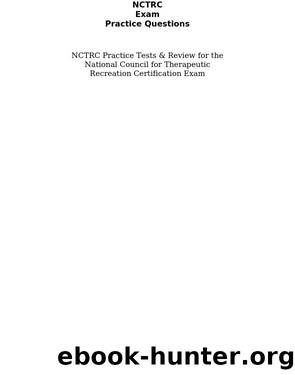NCTRC Exam Practice Questions by NCTRC Exam Secrets Test Prep Staff

Author:NCTRC Exam Secrets Test Prep Staff
Language: eng
Format: epub
Publisher: Mometrix Media LLC
Practice Test #2
1. The CTRS is encouraging team members to use the STAR approach to client safety. The CTRS explains that the STAR approach begins by
a. safeguarding clients.
b. stopping to concentrate on tasks.
c. securing needed equipment/tools.
d. selecting appropriate tasks.
2. A client with a history of aggression begins swearing and pacing back and forth, shouting, âYou canât make me stay here!â The MOST appropriate initial response is to
a. speak calmly and quietly to the client.
b. tell the client this behavior is inappropriate.
c. leave the room.
d. call security to restrain the client.
3. In evaluating research as part of the development of evidence-based practice guidelines, the four evaluative/trustworthiness criteria are (1) credibility, (2) dependability, (3) transferability, and (4)
a. controllability.
b. applicability.
c. accountability.
d. confirmability.
4. A client with multiple sclerosis tells the CTRS that she is upset that she can no longer continue her employment because her job is too physically demanding and is concerned about how she will support herself. Which of the following responses focuses on problem solving as a response to stress?
a. âWhat plans do you have for finding a new job?â
b. âYou might be eligible for public assistance.â
c. âIâm sure there is other work you can do.â
d. âI can see how upsetting that is for you.â
5. Under the Joint Commissionâs National Patient Safety Goals, which of the following is generally acceptable as one of two required identifiers?
a. Place of birth
b. Date of birth
c. Place of employment
d. Verifying clientâs name from armband taped to bedside stand
6. When advising parents about age-appropriate exercise for a 4-year-old child about to be discharged from the hospital after treatment for diabetes, which of the following activities is MOST appropriate?
a. Dancing or skating
b. Bicycling
c. Team sports
d. Gymnastics
7. Using the average cost of a problem and the cost of intervention to demonstrate savings is a(n)
a. cost-benefit analysis.
b. efficacy study.
c. product evaluation.
d. cost-effective analysis.
8. Listed below are the 5 stages of substance abuse:
1. Regular use.
2. Dependence.
3. Problem use.
4. Experimentation.
5. Addiction.
Which of the following correctly orders these stages from first to last?
a. 1, 2, 3, 4, 5
b. 3, 4, 2, 1, 5
c. 4, 1, 3, 2, 5
d. 4, 3, 2, 1, 5
9. Which of the following characteristics indicates that a dog is likely well-suited to be a therapy dog?
a. Guards toys and food
b. Likes to lick people
c. Very enthusiastic and excited about meeting people
d. Remains confident in different environments
10. If, when utilizing the Plan-Do-Study-Act (PDSA) method of continuous quality improvement, study of the outcomes of a trial indicates that the solution that was instituted was not effective, the next step is to
a. return to the Plan step.
b. return to the Do step.
c. discontinue the process.
d. continue to the Act step.
11. When reviewing a number of articles as part of development of evidence-based practice guidelines, the first step to reading critically should be to
a. review the authorâs credentials.
b. consider the source.
c. read the article conclusion.
d. evaluate the overall article.
12. The three primary elements of motivational interviewing are
a. collaboration, evocation, and autonomy.
b. orientation, identification, and termination.
c. input, discussion, output.
d. identification of barriers, conflict resolution, and implementation.
Download
This site does not store any files on its server. We only index and link to content provided by other sites. Please contact the content providers to delete copyright contents if any and email us, we'll remove relevant links or contents immediately.
Application of a Novel Technique for Clinical Evaluation of Nitric Oxide-Induced Free Radical Reactions in ICU Patients by Unknown(715)
Rosenâs Emergency Medicine Concepts and Clinical Practice by Ron Walls; Robert Hockberger; Marianne Gausche-Hill; Timothy B. Erickson; Susan R. Wilcox(588)
Oxidative damage to surfactant protein D in pulmonary diseases by Vitality Starosta1 & Matthias Griese1†(431)
Social Science Perspectives on Global Public Health by Vincent La Placa & Julia Morgan(393)
Genetic engineering of grain and pasture legumes for improved nutritive value by Unknown(379)
Constructing Canine Consent; Conceptualising and Adopting a Consent-focused Relationship with Dogs by ERIN JONES(349)
Organic Chemistry: An Acid - Base Approach by MICHAEL SMITH(320)
ADVANCED EMERGENCY CARE AND TRANSPORTATION OF THE SICK AND INJURED by Unknown(296)
Saunders Nursing Drug Handbook 2024 - E-Book by Unknown(285)
Diagnostic and Statistical Manual of Mental Disorders, Fifth Edition, Text Revision (DSM-5-TR(tm)) by Unknown(284)
Access to Medicines and Vaccines in the South : Coherence of Rules and Policies Applied by the European Union Commission by Stephen Kingah(280)
Davis's Comprehensive Manual of Laboratory and Diagnostic Tests with Nursing Implications by Unknown(267)
Human Microanatomy; Cell Tissue and Organ Histology with Celebrity Medical Histories by Stephen A. Stricker(264)
Socio-Life Science and the COVID-19 Outbreak : Public Health and Public Policy by Makoto Yano; Fumihiko Matsuda; Anavaj Sakuntabhai; Shigeru Hirota(264)
Berne and Levy Physiology E-Book by Unknown(251)
Replacing the Dead by Mie Nakachi;(249)
Handbook of Skin Disease Management by Jiyad Zainab;Flohr Carsten; & Carsten Flohr(247)
The Pocket Guide to Sensorimotor Psychotherapy in Context (Norton Series on Interpersonal Neurobiology) by Pat Ogden(242)
Deep Learning and Medical Applications by Unknown(238)
